Solved Financial Accounting - Assignment (Doc)
VerifiedAdded on 2021/02/20
|16
|3926
|79
AI Summary
Contribute Materials
Your contribution can guide someone’s learning journey. Share your
documents today.
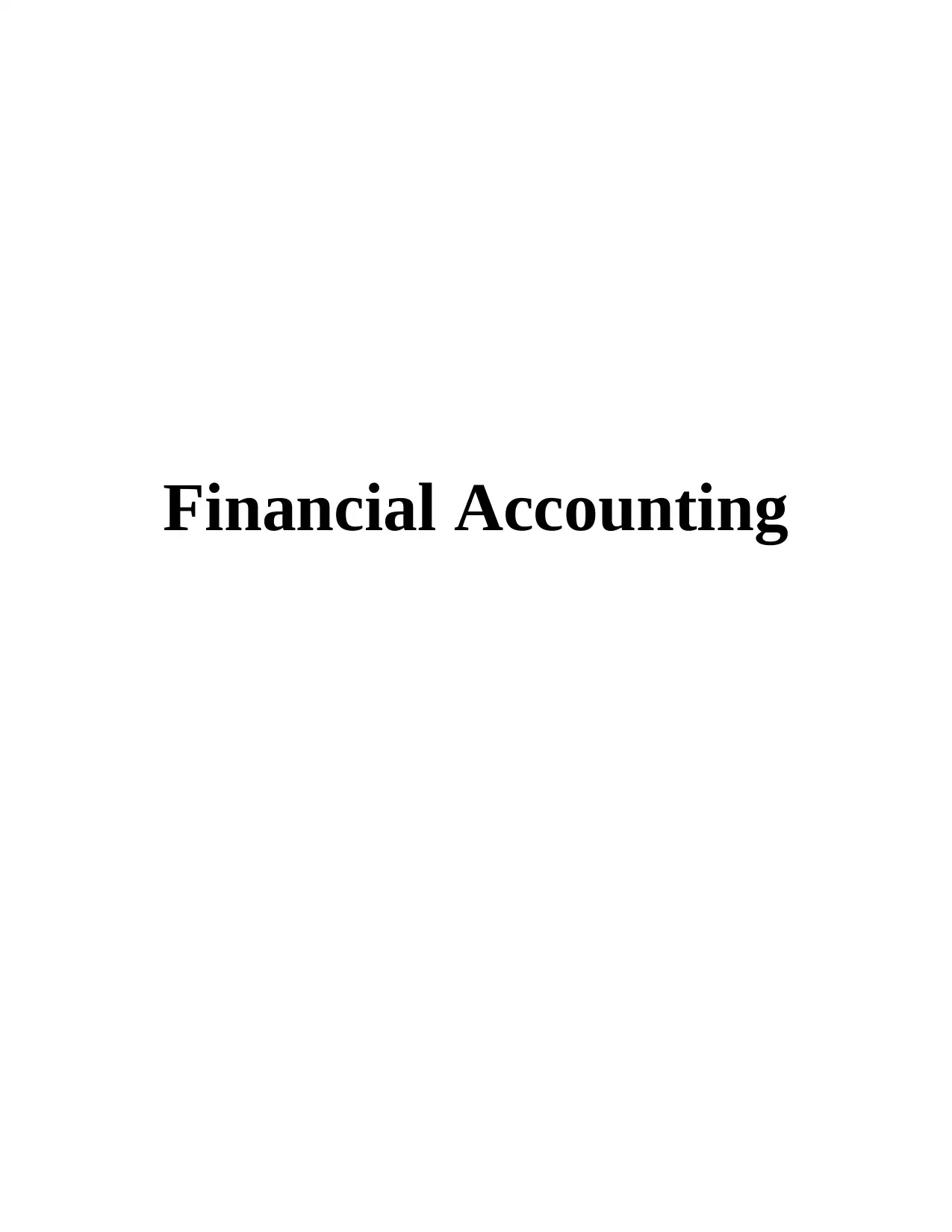
Financial Accounting
Secure Best Marks with AI Grader
Need help grading? Try our AI Grader for instant feedback on your assignments.
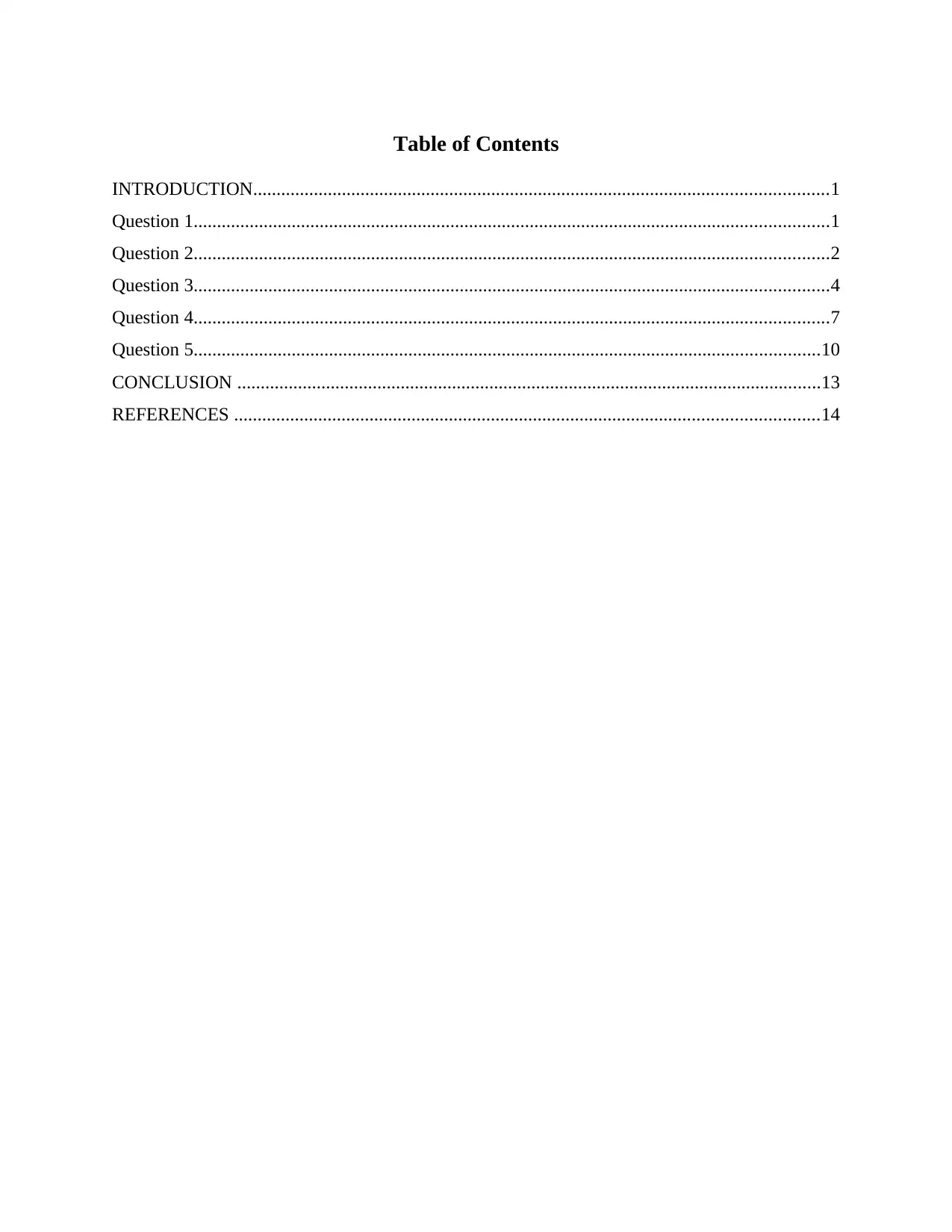
Table of Contents
INTRODUCTION...........................................................................................................................1
Question 1........................................................................................................................................1
Question 2........................................................................................................................................2
Question 3........................................................................................................................................4
Question 4........................................................................................................................................7
Question 5......................................................................................................................................10
CONCLUSION .............................................................................................................................13
REFERENCES .............................................................................................................................14
INTRODUCTION...........................................................................................................................1
Question 1........................................................................................................................................1
Question 2........................................................................................................................................2
Question 3........................................................................................................................................4
Question 4........................................................................................................................................7
Question 5......................................................................................................................................10
CONCLUSION .............................................................................................................................13
REFERENCES .............................................................................................................................14
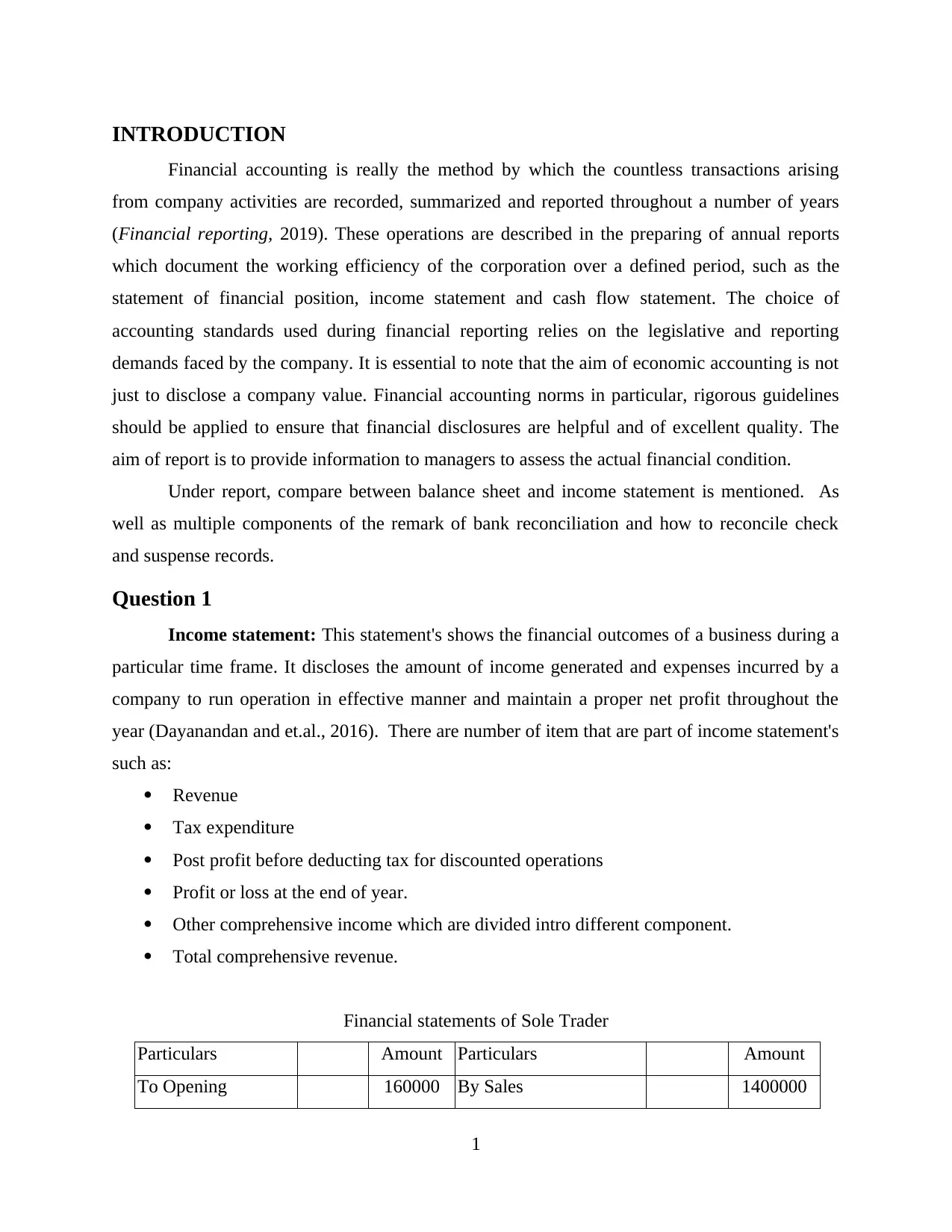
INTRODUCTION
Financial accounting is really the method by which the countless transactions arising
from company activities are recorded, summarized and reported throughout a number of years
(Financial reporting, 2019). These operations are described in the preparing of annual reports
which document the working efficiency of the corporation over a defined period, such as the
statement of financial position, income statement and cash flow statement. The choice of
accounting standards used during financial reporting relies on the legislative and reporting
demands faced by the company. It is essential to note that the aim of economic accounting is not
just to disclose a company value. Financial accounting norms in particular, rigorous guidelines
should be applied to ensure that financial disclosures are helpful and of excellent quality. The
aim of report is to provide information to managers to assess the actual financial condition.
Under report, compare between balance sheet and income statement is mentioned. As
well as multiple components of the remark of bank reconciliation and how to reconcile check
and suspense records.
Question 1
Income statement: This statement's shows the financial outcomes of a business during a
particular time frame. It discloses the amount of income generated and expenses incurred by a
company to run operation in effective manner and maintain a proper net profit throughout the
year (Dayanandan and et.al., 2016). There are number of item that are part of income statement's
such as:
Revenue
Tax expenditure
Post profit before deducting tax for discounted operations
Profit or loss at the end of year.
Other comprehensive income which are divided intro different component.
Total comprehensive revenue.
Financial statements of Sole Trader
Particulars Amount Particulars Amount
To Opening 160000 By Sales 1400000
1
Financial accounting is really the method by which the countless transactions arising
from company activities are recorded, summarized and reported throughout a number of years
(Financial reporting, 2019). These operations are described in the preparing of annual reports
which document the working efficiency of the corporation over a defined period, such as the
statement of financial position, income statement and cash flow statement. The choice of
accounting standards used during financial reporting relies on the legislative and reporting
demands faced by the company. It is essential to note that the aim of economic accounting is not
just to disclose a company value. Financial accounting norms in particular, rigorous guidelines
should be applied to ensure that financial disclosures are helpful and of excellent quality. The
aim of report is to provide information to managers to assess the actual financial condition.
Under report, compare between balance sheet and income statement is mentioned. As
well as multiple components of the remark of bank reconciliation and how to reconcile check
and suspense records.
Question 1
Income statement: This statement's shows the financial outcomes of a business during a
particular time frame. It discloses the amount of income generated and expenses incurred by a
company to run operation in effective manner and maintain a proper net profit throughout the
year (Dayanandan and et.al., 2016). There are number of item that are part of income statement's
such as:
Revenue
Tax expenditure
Post profit before deducting tax for discounted operations
Profit or loss at the end of year.
Other comprehensive income which are divided intro different component.
Total comprehensive revenue.
Financial statements of Sole Trader
Particulars Amount Particulars Amount
To Opening 160000 By Sales 1400000
1
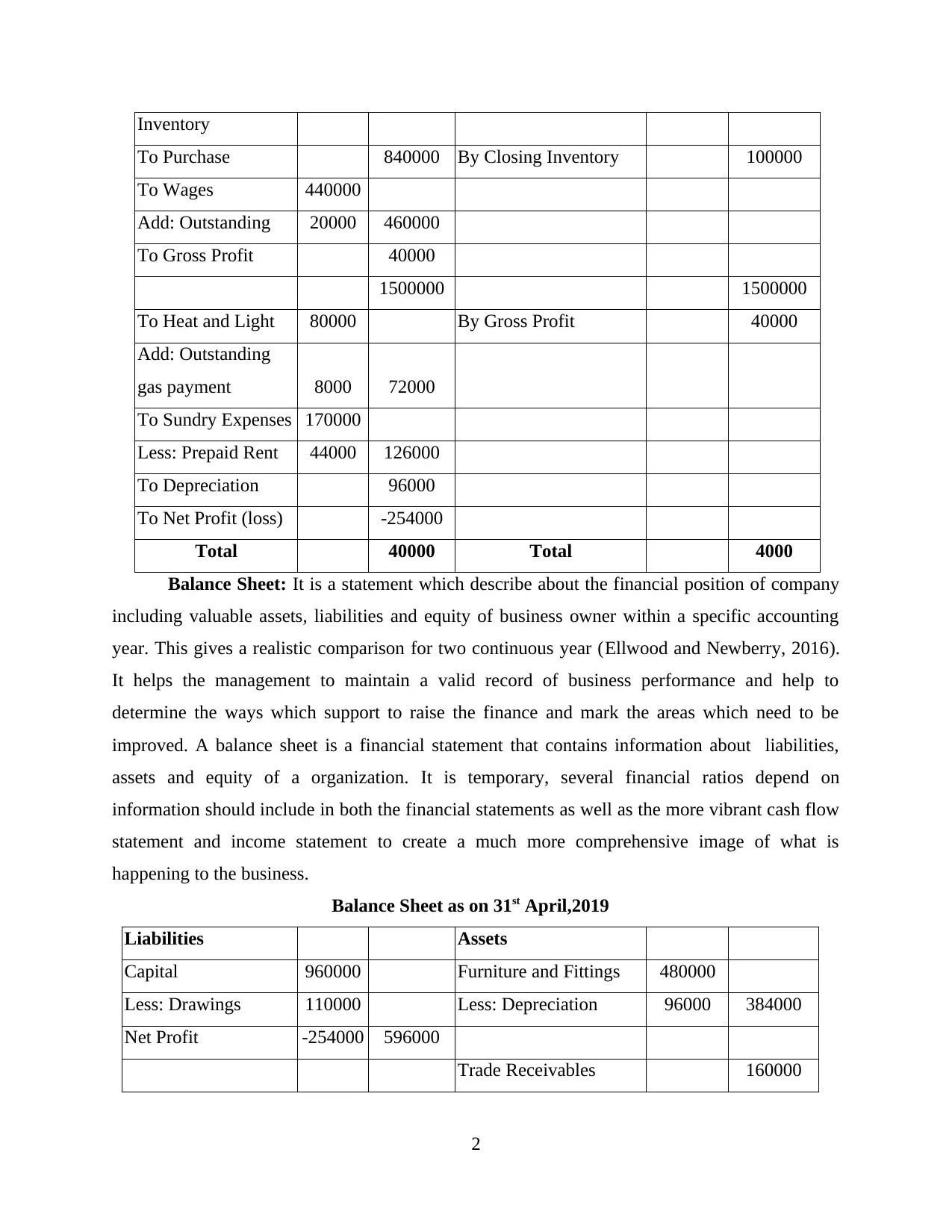
Inventory
To Purchase 840000 By Closing Inventory 100000
To Wages 440000
Add: Outstanding 20000 460000
To Gross Profit 40000
1500000 1500000
To Heat and Light 80000 By Gross Profit 40000
Add: Outstanding
gas payment 8000 72000
To Sundry Expenses 170000
Less: Prepaid Rent 44000 126000
To Depreciation 96000
To Net Profit (loss) -254000
Total 40000 Total 4000
Balance Sheet: It is a statement which describe about the financial position of company
including valuable assets, liabilities and equity of business owner within a specific accounting
year. This gives a realistic comparison for two continuous year (Ellwood and Newberry, 2016).
It helps the management to maintain a valid record of business performance and help to
determine the ways which support to raise the finance and mark the areas which need to be
improved. A balance sheet is a financial statement that contains information about liabilities,
assets and equity of a organization. It is temporary, several financial ratios depend on
information should include in both the financial statements as well as the more vibrant cash flow
statement and income statement to create a much more comprehensive image of what is
happening to the business.
Balance Sheet as on 31st April,2019
Liabilities Assets
Capital 960000 Furniture and Fittings 480000
Less: Drawings 110000 Less: Depreciation 96000 384000
Net Profit -254000 596000
Trade Receivables 160000
2
To Purchase 840000 By Closing Inventory 100000
To Wages 440000
Add: Outstanding 20000 460000
To Gross Profit 40000
1500000 1500000
To Heat and Light 80000 By Gross Profit 40000
Add: Outstanding
gas payment 8000 72000
To Sundry Expenses 170000
Less: Prepaid Rent 44000 126000
To Depreciation 96000
To Net Profit (loss) -254000
Total 40000 Total 4000
Balance Sheet: It is a statement which describe about the financial position of company
including valuable assets, liabilities and equity of business owner within a specific accounting
year. This gives a realistic comparison for two continuous year (Ellwood and Newberry, 2016).
It helps the management to maintain a valid record of business performance and help to
determine the ways which support to raise the finance and mark the areas which need to be
improved. A balance sheet is a financial statement that contains information about liabilities,
assets and equity of a organization. It is temporary, several financial ratios depend on
information should include in both the financial statements as well as the more vibrant cash flow
statement and income statement to create a much more comprehensive image of what is
happening to the business.
Balance Sheet as on 31st April,2019
Liabilities Assets
Capital 960000 Furniture and Fittings 480000
Less: Drawings 110000 Less: Depreciation 96000 384000
Net Profit -254000 596000
Trade Receivables 160000
2
Secure Best Marks with AI Grader
Need help grading? Try our AI Grader for instant feedback on your assignments.
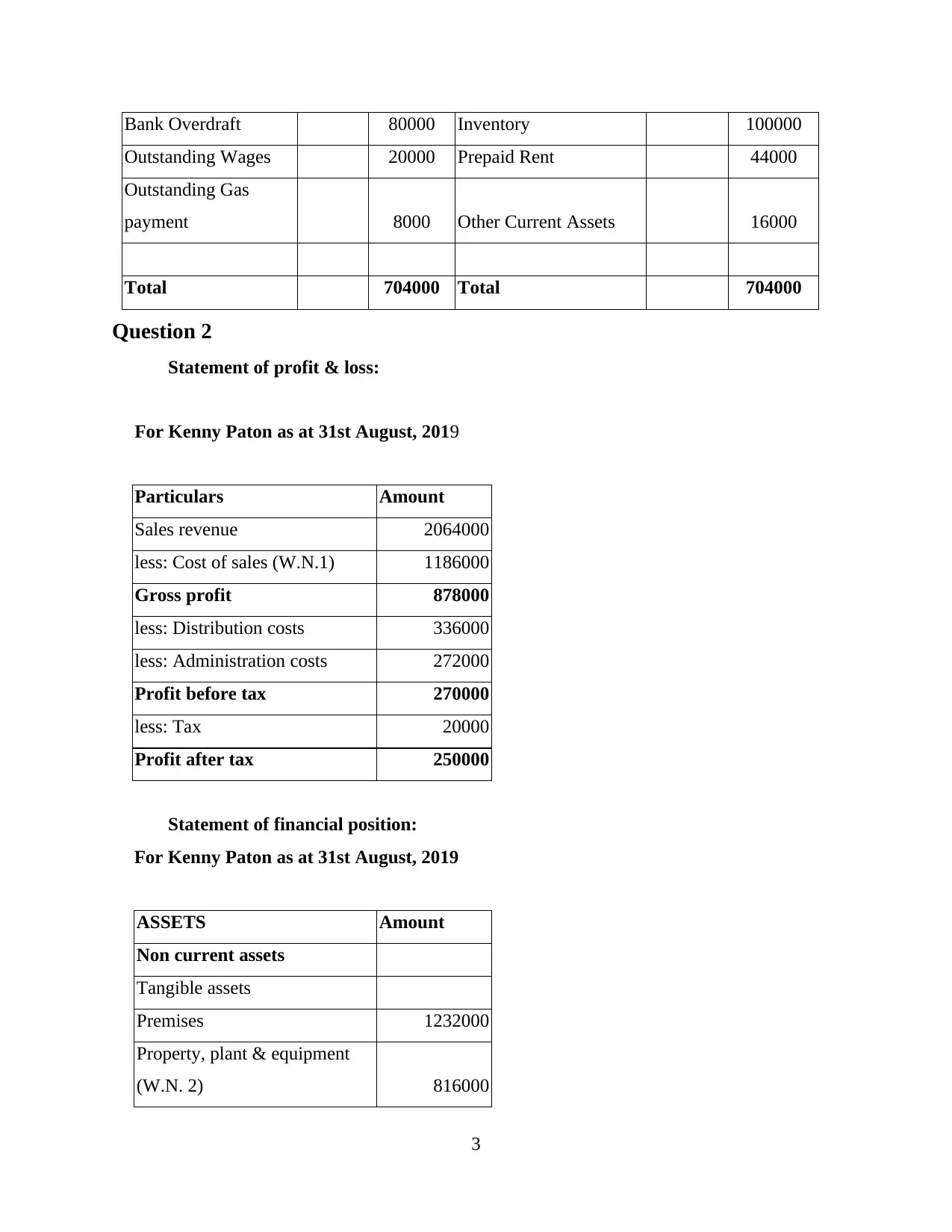
Bank Overdraft 80000 Inventory 100000
Outstanding Wages 20000 Prepaid Rent 44000
Outstanding Gas
payment 8000 Other Current Assets 16000
Total 704000 Total 704000
Question 2
Statement of profit & loss:
For Kenny Paton as at 31st August, 2019
Particulars Amount
Sales revenue 2064000
less: Cost of sales (W.N.1) 1186000
Gross profit 878000
less: Distribution costs 336000
less: Administration costs 272000
Profit before tax 270000
less: Tax 20000
Profit after tax 250000
Statement of financial position:
For Kenny Paton as at 31st August, 2019
ASSETS Amount
Non current assets
Tangible assets
Premises 1232000
Property, plant & equipment
(W.N. 2) 816000
3
Outstanding Wages 20000 Prepaid Rent 44000
Outstanding Gas
payment 8000 Other Current Assets 16000
Total 704000 Total 704000
Question 2
Statement of profit & loss:
For Kenny Paton as at 31st August, 2019
Particulars Amount
Sales revenue 2064000
less: Cost of sales (W.N.1) 1186000
Gross profit 878000
less: Distribution costs 336000
less: Administration costs 272000
Profit before tax 270000
less: Tax 20000
Profit after tax 250000
Statement of financial position:
For Kenny Paton as at 31st August, 2019
ASSETS Amount
Non current assets
Tangible assets
Premises 1232000
Property, plant & equipment
(W.N. 2) 816000
3

Current assets
Trade receivables 608000
Bank 32000
Inventory 78000
Total assets 2766000
EQUITY & LIABILITIES
Equity
Ordinary share capital 1328000
Reserves (W.N. 4) 117200
Non current liabilities
5 year 13% loan 528000
Dividend (W.N. 3) 132800
Current liabilities
Trade payables 640000
Tax 20000
Total equity & liabilities 2766000
Working notes:
1) Cost of sales:
Particulars Amount
Opening inventory 96000
Purchases 1024000
Less: closing inventory 78000
Depreciation: plant & equipment 115200
Office equipment 28800
Total 1186000
4
Trade receivables 608000
Bank 32000
Inventory 78000
Total assets 2766000
EQUITY & LIABILITIES
Equity
Ordinary share capital 1328000
Reserves (W.N. 4) 117200
Non current liabilities
5 year 13% loan 528000
Dividend (W.N. 3) 132800
Current liabilities
Trade payables 640000
Tax 20000
Total equity & liabilities 2766000
Working notes:
1) Cost of sales:
Particulars Amount
Opening inventory 96000
Purchases 1024000
Less: closing inventory 78000
Depreciation: plant & equipment 115200
Office equipment 28800
Total 1186000
4
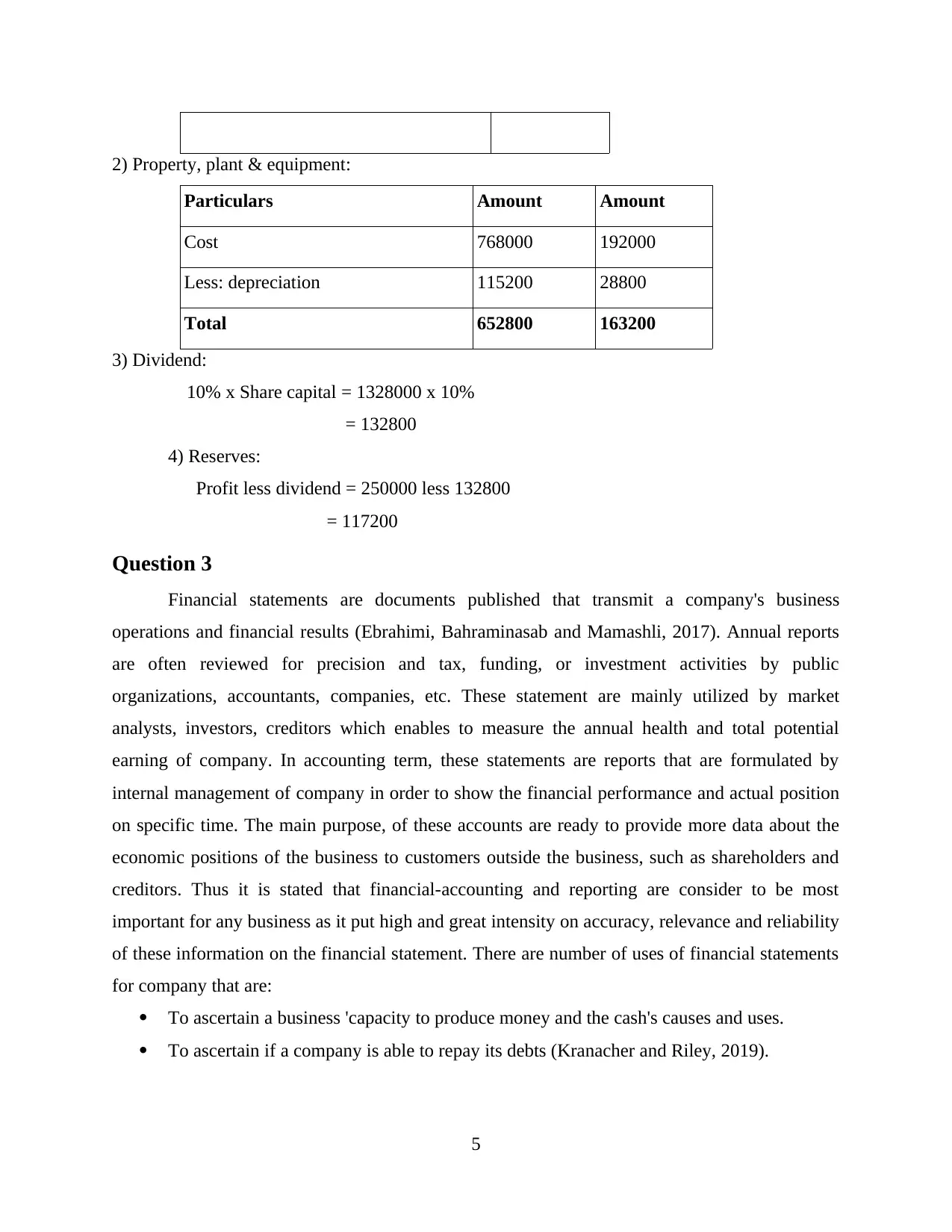
2) Property, plant & equipment:
Particulars Amount Amount
Cost 768000 192000
Less: depreciation 115200 28800
Total 652800 163200
3) Dividend:
10% x Share capital = 1328000 x 10%
= 132800
4) Reserves:
Profit less dividend = 250000 less 132800
= 117200
Question 3
Financial statements are documents published that transmit a company's business
operations and financial results (Ebrahimi, Bahraminasab and Mamashli, 2017). Annual reports
are often reviewed for precision and tax, funding, or investment activities by public
organizations, accountants, companies, etc. These statement are mainly utilized by market
analysts, investors, creditors which enables to measure the annual health and total potential
earning of company. In accounting term, these statements are reports that are formulated by
internal management of company in order to show the financial performance and actual position
on specific time. The main purpose, of these accounts are ready to provide more data about the
economic positions of the business to customers outside the business, such as shareholders and
creditors. Thus it is stated that financial-accounting and reporting are consider to be most
important for any business as it put high and great intensity on accuracy, relevance and reliability
of these information on the financial statement. There are number of uses of financial statements
for company that are:
To ascertain a business 'capacity to produce money and the cash's causes and uses.
To ascertain if a company is able to repay its debts (Kranacher and Riley, 2019).
5
Particulars Amount Amount
Cost 768000 192000
Less: depreciation 115200 28800
Total 652800 163200
3) Dividend:
10% x Share capital = 1328000 x 10%
= 132800
4) Reserves:
Profit less dividend = 250000 less 132800
= 117200
Question 3
Financial statements are documents published that transmit a company's business
operations and financial results (Ebrahimi, Bahraminasab and Mamashli, 2017). Annual reports
are often reviewed for precision and tax, funding, or investment activities by public
organizations, accountants, companies, etc. These statement are mainly utilized by market
analysts, investors, creditors which enables to measure the annual health and total potential
earning of company. In accounting term, these statements are reports that are formulated by
internal management of company in order to show the financial performance and actual position
on specific time. The main purpose, of these accounts are ready to provide more data about the
economic positions of the business to customers outside the business, such as shareholders and
creditors. Thus it is stated that financial-accounting and reporting are consider to be most
important for any business as it put high and great intensity on accuracy, relevance and reliability
of these information on the financial statement. There are number of uses of financial statements
for company that are:
To ascertain a business 'capacity to produce money and the cash's causes and uses.
To ascertain if a company is able to repay its debts (Kranacher and Riley, 2019).
5
Paraphrase This Document
Need a fresh take? Get an instant paraphrase of this document with our AI Paraphraser
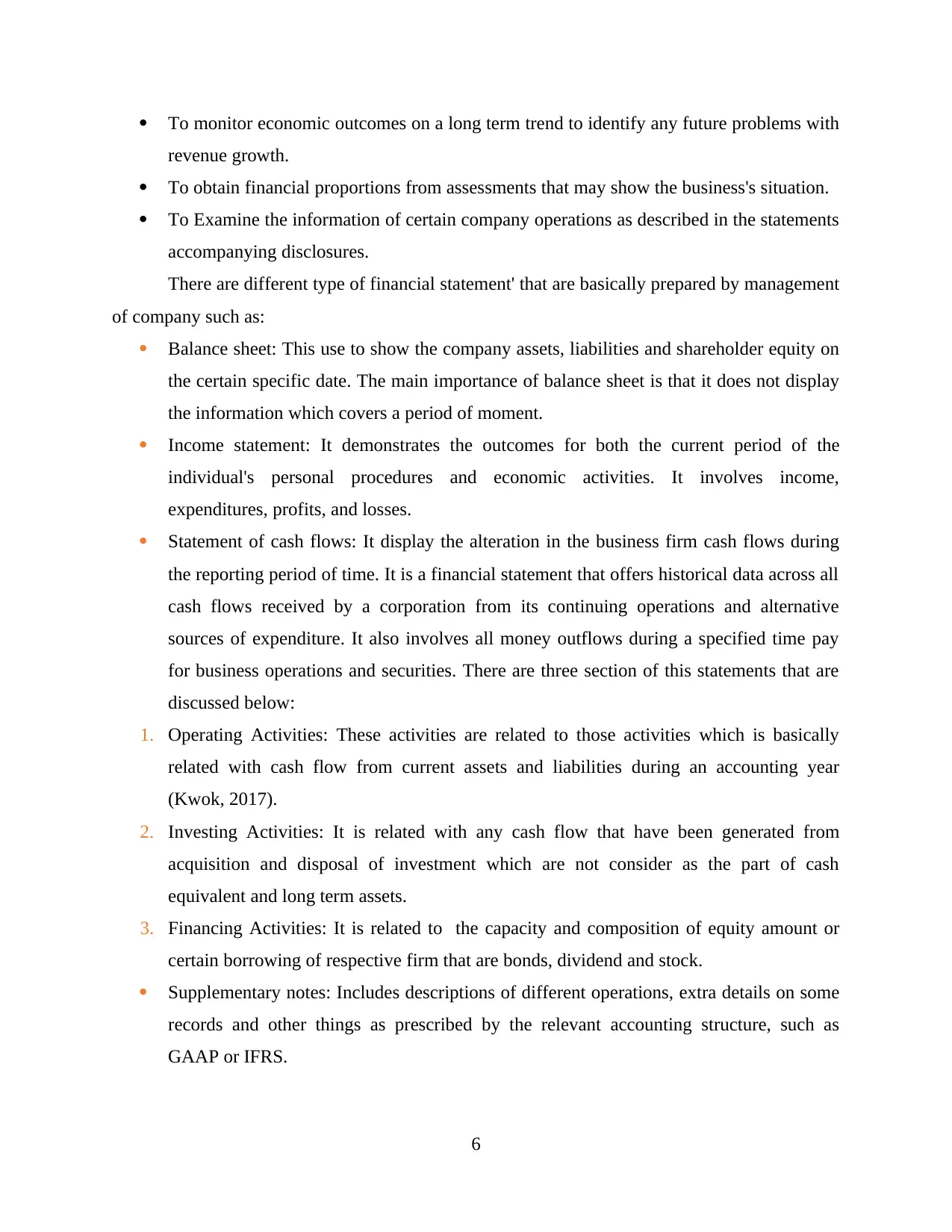
To monitor economic outcomes on a long term trend to identify any future problems with
revenue growth.
To obtain financial proportions from assessments that may show the business's situation.
To Examine the information of certain company operations as described in the statements
accompanying disclosures.
There are different type of financial statement' that are basically prepared by management
of company such as:
Balance sheet: This use to show the company assets, liabilities and shareholder equity on
the certain specific date. The main importance of balance sheet is that it does not display
the information which covers a period of moment.
Income statement: It demonstrates the outcomes for both the current period of the
individual's personal procedures and economic activities. It involves income,
expenditures, profits, and losses.
Statement of cash flows: It display the alteration in the business firm cash flows during
the reporting period of time. It is a financial statement that offers historical data across all
cash flows received by a corporation from its continuing operations and alternative
sources of expenditure. It also involves all money outflows during a specified time pay
for business operations and securities. There are three section of this statements that are
discussed below:
1. Operating Activities: These activities are related to those activities which is basically
related with cash flow from current assets and liabilities during an accounting year
(Kwok, 2017).
2. Investing Activities: It is related with any cash flow that have been generated from
acquisition and disposal of investment which are not consider as the part of cash
equivalent and long term assets.
3. Financing Activities: It is related to the capacity and composition of equity amount or
certain borrowing of respective firm that are bonds, dividend and stock.
Supplementary notes: Includes descriptions of different operations, extra details on some
records and other things as prescribed by the relevant accounting structure, such as
GAAP or IFRS.
6
revenue growth.
To obtain financial proportions from assessments that may show the business's situation.
To Examine the information of certain company operations as described in the statements
accompanying disclosures.
There are different type of financial statement' that are basically prepared by management
of company such as:
Balance sheet: This use to show the company assets, liabilities and shareholder equity on
the certain specific date. The main importance of balance sheet is that it does not display
the information which covers a period of moment.
Income statement: It demonstrates the outcomes for both the current period of the
individual's personal procedures and economic activities. It involves income,
expenditures, profits, and losses.
Statement of cash flows: It display the alteration in the business firm cash flows during
the reporting period of time. It is a financial statement that offers historical data across all
cash flows received by a corporation from its continuing operations and alternative
sources of expenditure. It also involves all money outflows during a specified time pay
for business operations and securities. There are three section of this statements that are
discussed below:
1. Operating Activities: These activities are related to those activities which is basically
related with cash flow from current assets and liabilities during an accounting year
(Kwok, 2017).
2. Investing Activities: It is related with any cash flow that have been generated from
acquisition and disposal of investment which are not consider as the part of cash
equivalent and long term assets.
3. Financing Activities: It is related to the capacity and composition of equity amount or
certain borrowing of respective firm that are bonds, dividend and stock.
Supplementary notes: Includes descriptions of different operations, extra details on some
records and other things as prescribed by the relevant accounting structure, such as
GAAP or IFRS.
6
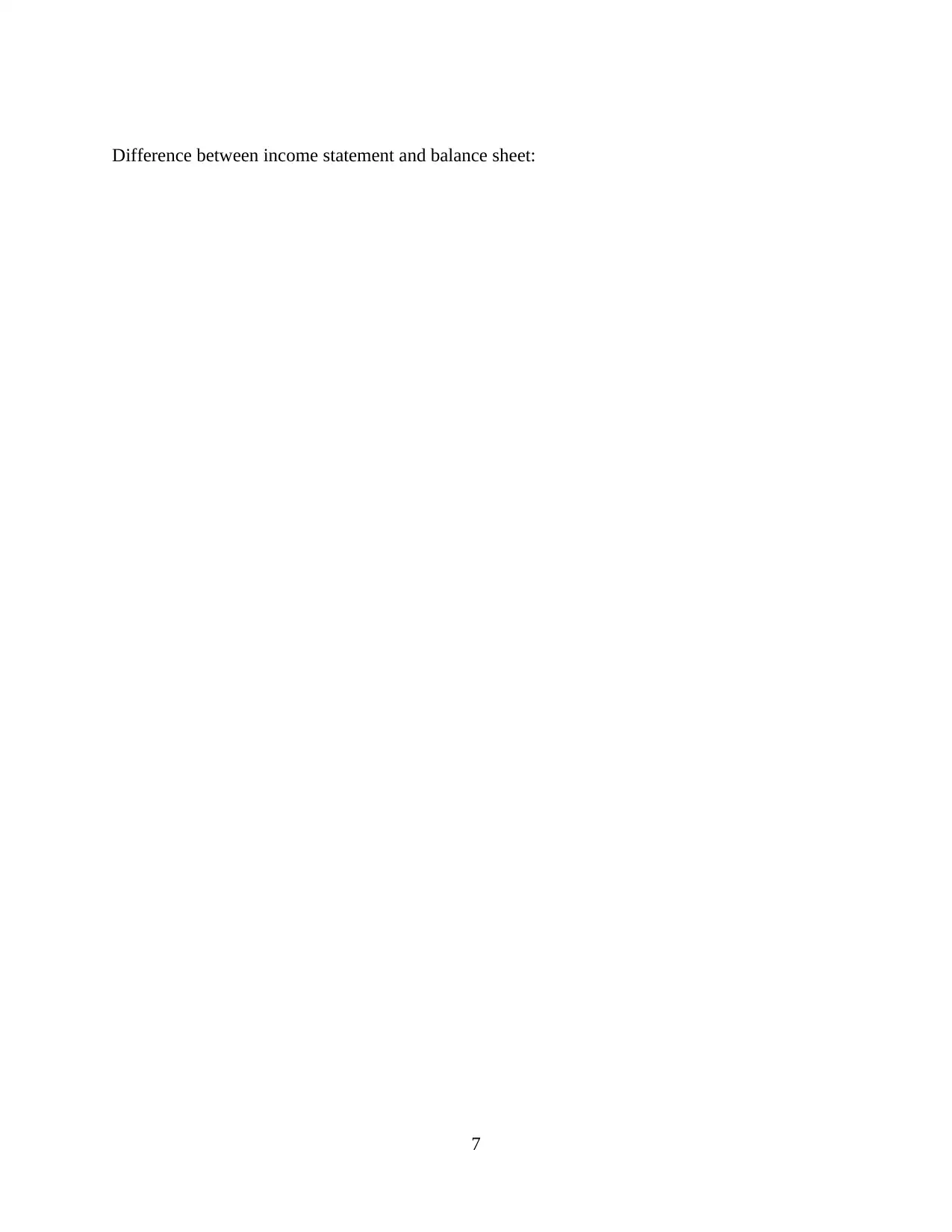
Difference between income statement and balance sheet:
7
7
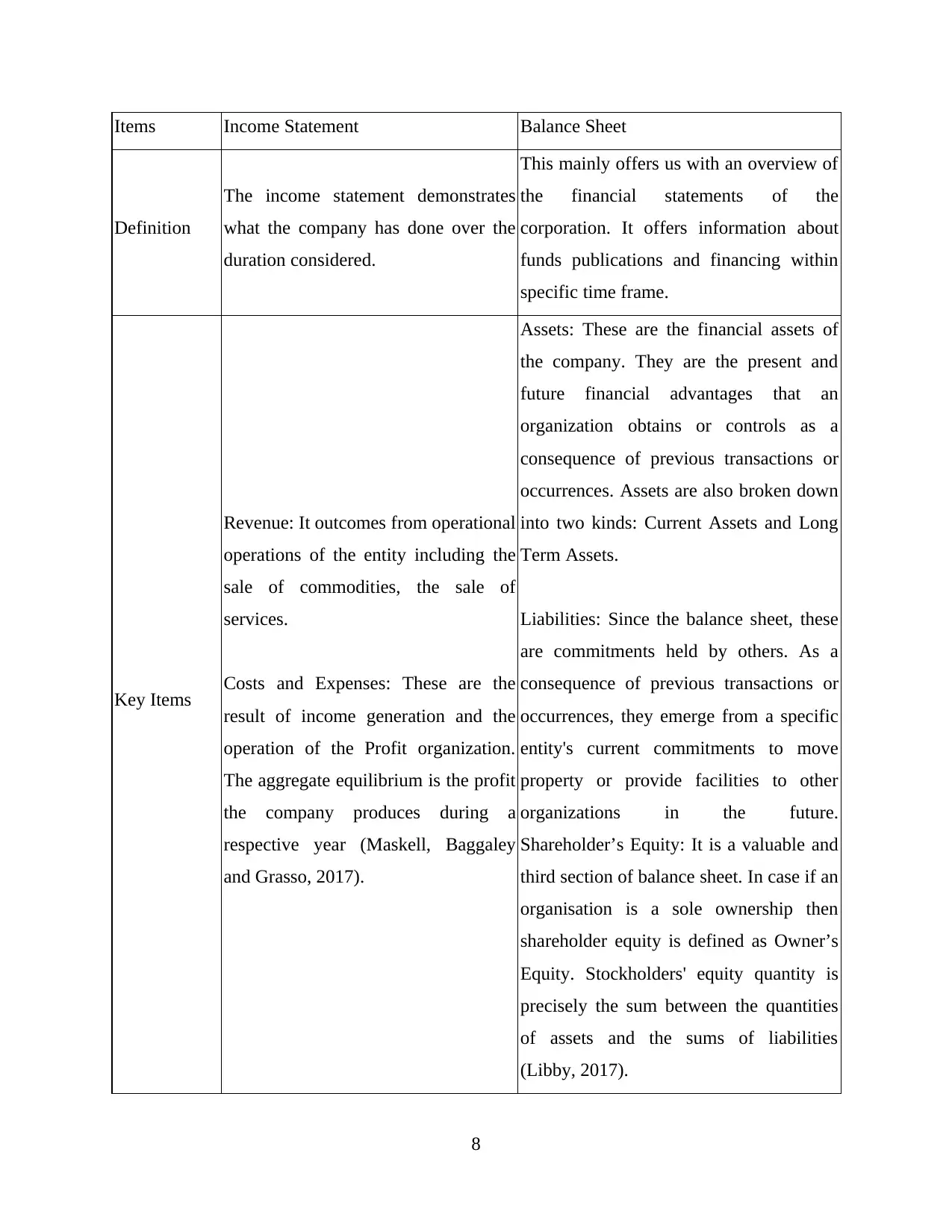
Items Income Statement Balance Sheet
Definition
The income statement demonstrates
what the company has done over the
duration considered.
This mainly offers us with an overview of
the financial statements of the
corporation. It offers information about
funds publications and financing within
specific time frame.
Key Items
Revenue: It outcomes from operational
operations of the entity including the
sale of commodities, the sale of
services.
Costs and Expenses: These are the
result of income generation and the
operation of the Profit organization.
The aggregate equilibrium is the profit
the company produces during a
respective year (Maskell, Baggaley
and Grasso, 2017).
Assets: These are the financial assets of
the company. They are the present and
future financial advantages that an
organization obtains or controls as a
consequence of previous transactions or
occurrences. Assets are also broken down
into two kinds: Current Assets and Long
Term Assets.
Liabilities: Since the balance sheet, these
are commitments held by others. As a
consequence of previous transactions or
occurrences, they emerge from a specific
entity's current commitments to move
property or provide facilities to other
organizations in the future.
Shareholder’s Equity: It is a valuable and
third section of balance sheet. In case if an
organisation is a sole ownership then
shareholder equity is defined as Owner’s
Equity. Stockholders' equity quantity is
precisely the sum between the quantities
of assets and the sums of liabilities
(Libby, 2017).
8
Definition
The income statement demonstrates
what the company has done over the
duration considered.
This mainly offers us with an overview of
the financial statements of the
corporation. It offers information about
funds publications and financing within
specific time frame.
Key Items
Revenue: It outcomes from operational
operations of the entity including the
sale of commodities, the sale of
services.
Costs and Expenses: These are the
result of income generation and the
operation of the Profit organization.
The aggregate equilibrium is the profit
the company produces during a
respective year (Maskell, Baggaley
and Grasso, 2017).
Assets: These are the financial assets of
the company. They are the present and
future financial advantages that an
organization obtains or controls as a
consequence of previous transactions or
occurrences. Assets are also broken down
into two kinds: Current Assets and Long
Term Assets.
Liabilities: Since the balance sheet, these
are commitments held by others. As a
consequence of previous transactions or
occurrences, they emerge from a specific
entity's current commitments to move
property or provide facilities to other
organizations in the future.
Shareholder’s Equity: It is a valuable and
third section of balance sheet. In case if an
organisation is a sole ownership then
shareholder equity is defined as Owner’s
Equity. Stockholders' equity quantity is
precisely the sum between the quantities
of assets and the sums of liabilities
(Libby, 2017).
8
Secure Best Marks with AI Grader
Need help grading? Try our AI Grader for instant feedback on your assignments.
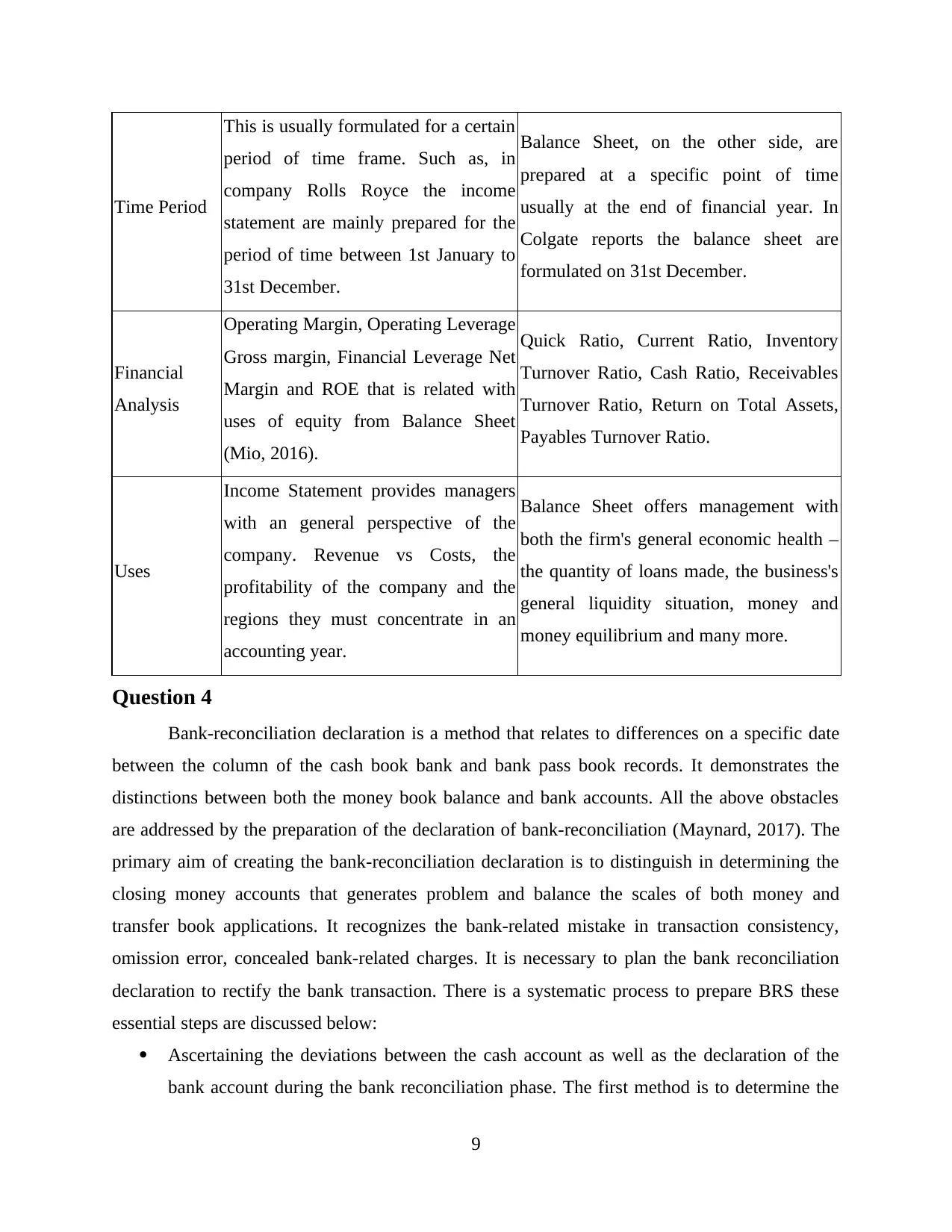
Time Period
This is usually formulated for a certain
period of time frame. Such as, in
company Rolls Royce the income
statement are mainly prepared for the
period of time between 1st January to
31st December.
Balance Sheet, on the other side, are
prepared at a specific point of time
usually at the end of financial year. In
Colgate reports the balance sheet are
formulated on 31st December.
Financial
Analysis
Operating Margin, Operating Leverage
Gross margin, Financial Leverage Net
Margin and ROE that is related with
uses of equity from Balance Sheet
(Mio, 2016).
Quick Ratio, Current Ratio, Inventory
Turnover Ratio, Cash Ratio, Receivables
Turnover Ratio, Return on Total Assets,
Payables Turnover Ratio.
Uses
Income Statement provides managers
with an general perspective of the
company. Revenue vs Costs, the
profitability of the company and the
regions they must concentrate in an
accounting year.
Balance Sheet offers management with
both the firm's general economic health –
the quantity of loans made, the business's
general liquidity situation, money and
money equilibrium and many more.
Question 4
Bank-reconciliation declaration is a method that relates to differences on a specific date
between the column of the cash book bank and bank pass book records. It demonstrates the
distinctions between both the money book balance and bank accounts. All the above obstacles
are addressed by the preparation of the declaration of bank-reconciliation (Maynard, 2017). The
primary aim of creating the bank-reconciliation declaration is to distinguish in determining the
closing money accounts that generates problem and balance the scales of both money and
transfer book applications. It recognizes the bank-related mistake in transaction consistency,
omission error, concealed bank-related charges. It is necessary to plan the bank reconciliation
declaration to rectify the bank transaction. There is a systematic process to prepare BRS these
essential steps are discussed below:
Ascertaining the deviations between the cash account as well as the declaration of the
bank account during the bank reconciliation phase. The first method is to determine the
9
This is usually formulated for a certain
period of time frame. Such as, in
company Rolls Royce the income
statement are mainly prepared for the
period of time between 1st January to
31st December.
Balance Sheet, on the other side, are
prepared at a specific point of time
usually at the end of financial year. In
Colgate reports the balance sheet are
formulated on 31st December.
Financial
Analysis
Operating Margin, Operating Leverage
Gross margin, Financial Leverage Net
Margin and ROE that is related with
uses of equity from Balance Sheet
(Mio, 2016).
Quick Ratio, Current Ratio, Inventory
Turnover Ratio, Cash Ratio, Receivables
Turnover Ratio, Return on Total Assets,
Payables Turnover Ratio.
Uses
Income Statement provides managers
with an general perspective of the
company. Revenue vs Costs, the
profitability of the company and the
regions they must concentrate in an
accounting year.
Balance Sheet offers management with
both the firm's general economic health –
the quantity of loans made, the business's
general liquidity situation, money and
money equilibrium and many more.
Question 4
Bank-reconciliation declaration is a method that relates to differences on a specific date
between the column of the cash book bank and bank pass book records. It demonstrates the
distinctions between both the money book balance and bank accounts. All the above obstacles
are addressed by the preparation of the declaration of bank-reconciliation (Maynard, 2017). The
primary aim of creating the bank-reconciliation declaration is to distinguish in determining the
closing money accounts that generates problem and balance the scales of both money and
transfer book applications. It recognizes the bank-related mistake in transaction consistency,
omission error, concealed bank-related charges. It is necessary to plan the bank reconciliation
declaration to rectify the bank transaction. There is a systematic process to prepare BRS these
essential steps are discussed below:
Ascertaining the deviations between the cash account as well as the declaration of the
bank account during the bank reconciliation phase. The first method is to determine the
9
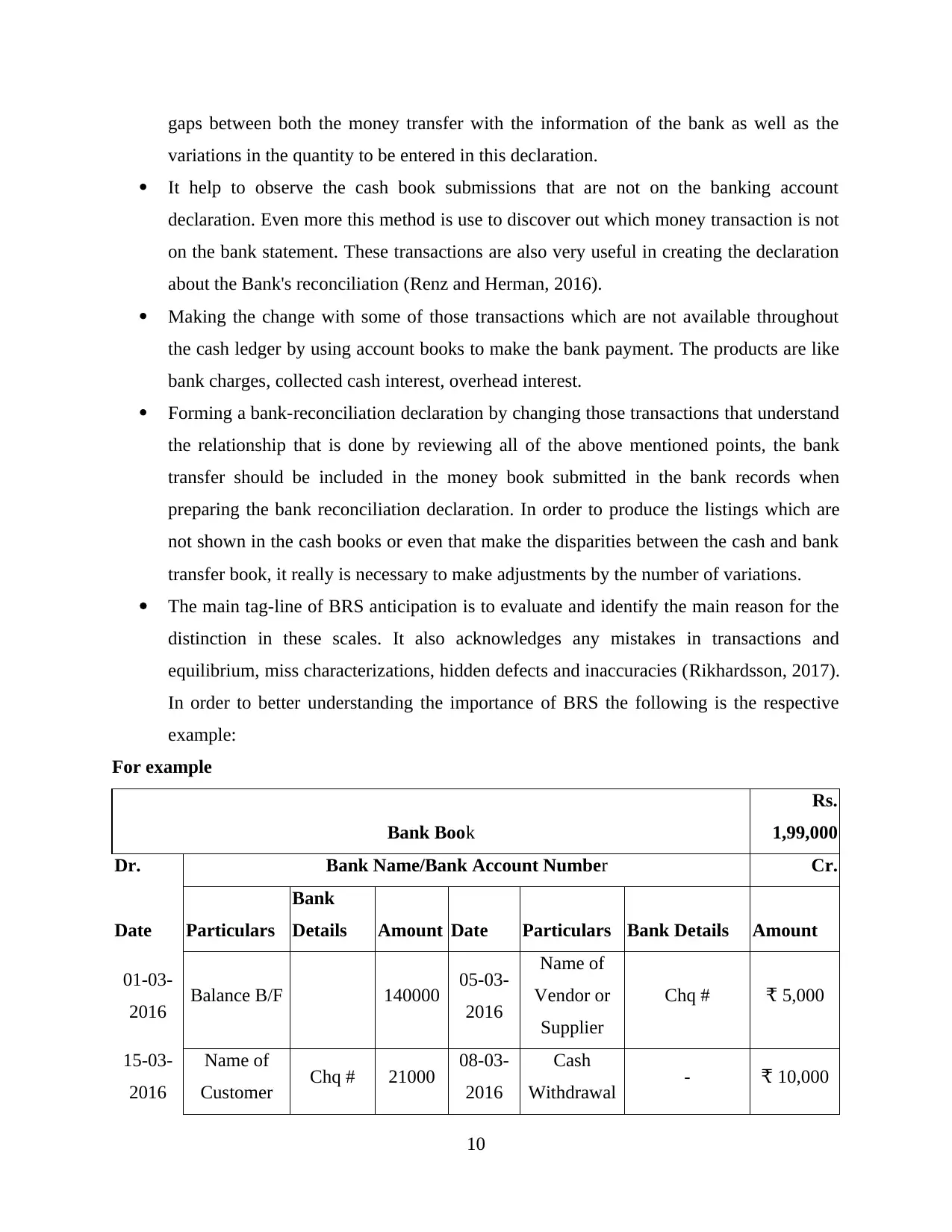
gaps between both the money transfer with the information of the bank as well as the
variations in the quantity to be entered in this declaration.
It help to observe the cash book submissions that are not on the banking account
declaration. Even more this method is use to discover out which money transaction is not
on the bank statement. These transactions are also very useful in creating the declaration
about the Bank's reconciliation (Renz and Herman, 2016).
Making the change with some of those transactions which are not available throughout
the cash ledger by using account books to make the bank payment. The products are like
bank charges, collected cash interest, overhead interest.
Forming a bank-reconciliation declaration by changing those transactions that understand
the relationship that is done by reviewing all of the above mentioned points, the bank
transfer should be included in the money book submitted in the bank records when
preparing the bank reconciliation declaration. In order to produce the listings which are
not shown in the cash books or even that make the disparities between the cash and bank
transfer book, it really is necessary to make adjustments by the number of variations.
The main tag-line of BRS anticipation is to evaluate and identify the main reason for the
distinction in these scales. It also acknowledges any mistakes in transactions and
equilibrium, miss characterizations, hidden defects and inaccuracies (Rikhardsson, 2017).
In order to better understanding the importance of BRS the following is the respective
example:
For example
Bank Book
Rs.
1,99,000
Dr. Bank Name/Bank Account Number Cr.
Date Particulars
Bank
Details Amount Date Particulars Bank Details Amount
01-03-
2016 Balance B/F 140000 05-03-
2016
Name of
Vendor or
Supplier
Chq # ₹ 5,000
15-03-
2016
Name of
Customer Chq # 21000 08-03-
2016
Cash
Withdrawal - ₹ 10,000
10
variations in the quantity to be entered in this declaration.
It help to observe the cash book submissions that are not on the banking account
declaration. Even more this method is use to discover out which money transaction is not
on the bank statement. These transactions are also very useful in creating the declaration
about the Bank's reconciliation (Renz and Herman, 2016).
Making the change with some of those transactions which are not available throughout
the cash ledger by using account books to make the bank payment. The products are like
bank charges, collected cash interest, overhead interest.
Forming a bank-reconciliation declaration by changing those transactions that understand
the relationship that is done by reviewing all of the above mentioned points, the bank
transfer should be included in the money book submitted in the bank records when
preparing the bank reconciliation declaration. In order to produce the listings which are
not shown in the cash books or even that make the disparities between the cash and bank
transfer book, it really is necessary to make adjustments by the number of variations.
The main tag-line of BRS anticipation is to evaluate and identify the main reason for the
distinction in these scales. It also acknowledges any mistakes in transactions and
equilibrium, miss characterizations, hidden defects and inaccuracies (Rikhardsson, 2017).
In order to better understanding the importance of BRS the following is the respective
example:
For example
Bank Book
Rs.
1,99,000
Dr. Bank Name/Bank Account Number Cr.
Date Particulars
Bank
Details Amount Date Particulars Bank Details Amount
01-03-
2016 Balance B/F 140000 05-03-
2016
Name of
Vendor or
Supplier
Chq # ₹ 5,000
15-03-
2016
Name of
Customer Chq # 21000 08-03-
2016
Cash
Withdrawal - ₹ 10,000
10
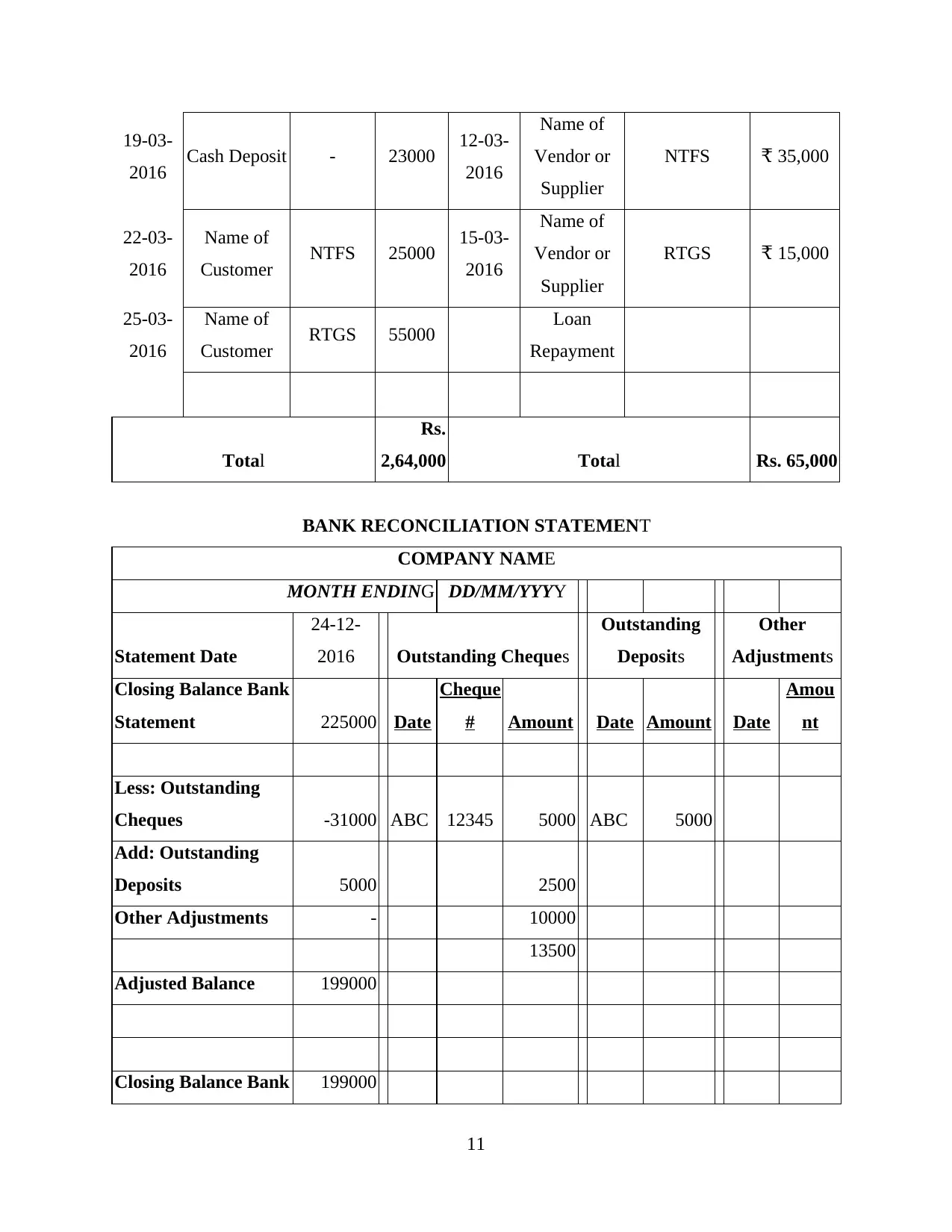
19-03-
2016 Cash Deposit - 23000 12-03-
2016
Name of
Vendor or
Supplier
NTFS ₹ 35,000
22-03-
2016
Name of
Customer NTFS 25000 15-03-
2016
Name of
Vendor or
Supplier
RTGS ₹ 15,000
25-03-
2016
Name of
Customer RTGS 55000 Loan
Repayment
Total
Rs.
2,64,000 Total Rs. 65,000
BANK RECONCILIATION STATEMENT
COMPANY NAME
MONTH ENDING DD/MM/YYYY
Statement Date
24-12-
2016 Outstanding Cheques
Outstanding
Deposits
Other
Adjustments
Closing Balance Bank
Statement 225000 Date
Cheque
# Amount Date Amount Date
Amou
nt
Less: Outstanding
Cheques -31000 ABC 12345 5000 ABC 5000
Add: Outstanding
Deposits 5000 2500
Other Adjustments - 10000
13500
Adjusted Balance 199000
Closing Balance Bank 199000
11
2016 Cash Deposit - 23000 12-03-
2016
Name of
Vendor or
Supplier
NTFS ₹ 35,000
22-03-
2016
Name of
Customer NTFS 25000 15-03-
2016
Name of
Vendor or
Supplier
RTGS ₹ 15,000
25-03-
2016
Name of
Customer RTGS 55000 Loan
Repayment
Total
Rs.
2,64,000 Total Rs. 65,000
BANK RECONCILIATION STATEMENT
COMPANY NAME
MONTH ENDING DD/MM/YYYY
Statement Date
24-12-
2016 Outstanding Cheques
Outstanding
Deposits
Other
Adjustments
Closing Balance Bank
Statement 225000 Date
Cheque
# Amount Date Amount Date
Amou
nt
Less: Outstanding
Cheques -31000 ABC 12345 5000 ABC 5000
Add: Outstanding
Deposits 5000 2500
Other Adjustments - 10000
13500
Adjusted Balance 199000
Closing Balance Bank 199000
11
Paraphrase This Document
Need a fresh take? Get an instant paraphrase of this document with our AI Paraphraser
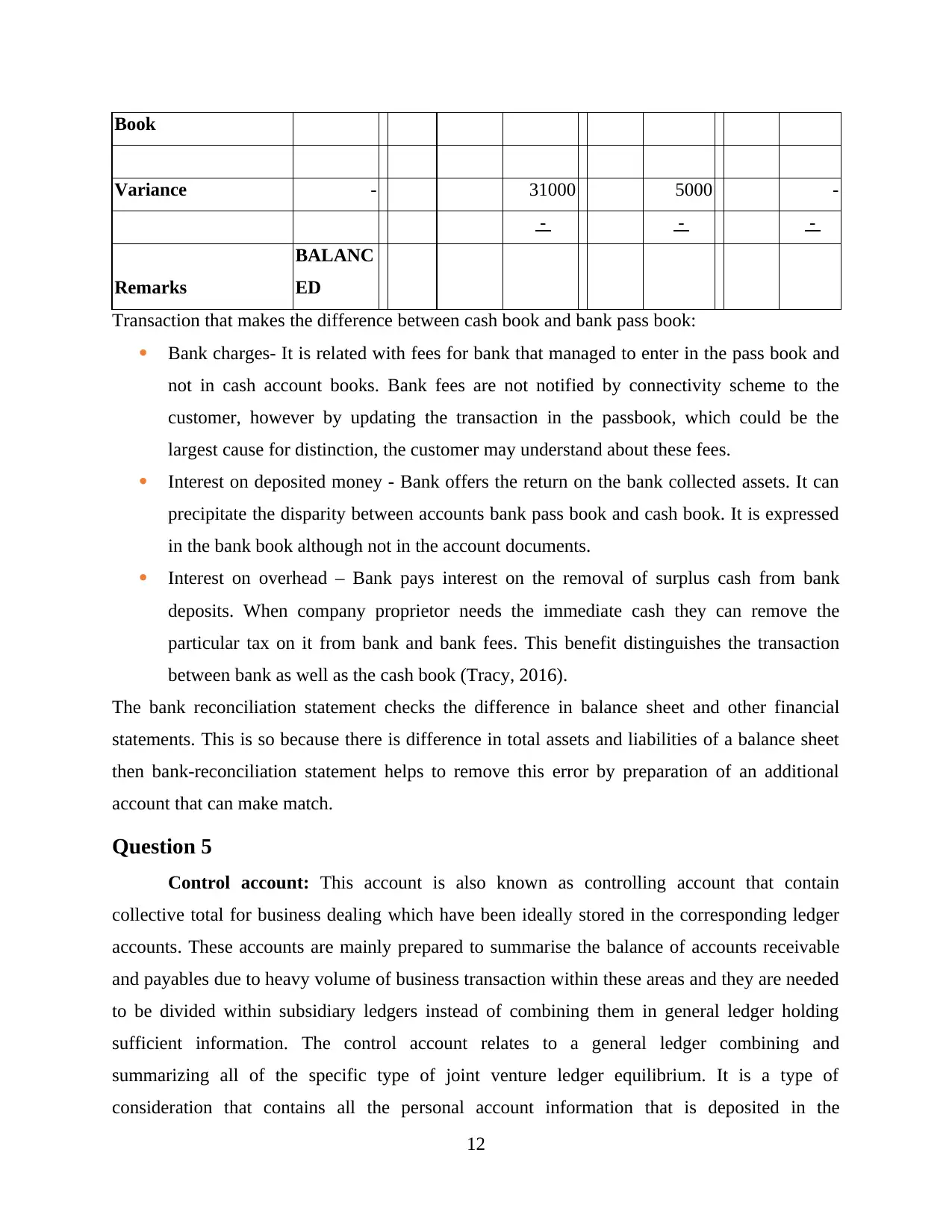
Book
Variance - 31000 5000 -
- - -
Remarks
BALANC
ED
Transaction that makes the difference between cash book and bank pass book:
Bank charges- It is related with fees for bank that managed to enter in the pass book and
not in cash account books. Bank fees are not notified by connectivity scheme to the
customer, however by updating the transaction in the passbook, which could be the
largest cause for distinction, the customer may understand about these fees.
Interest on deposited money - Bank offers the return on the bank collected assets. It can
precipitate the disparity between accounts bank pass book and cash book. It is expressed
in the bank book although not in the account documents.
Interest on overhead – Bank pays interest on the removal of surplus cash from bank
deposits. When company proprietor needs the immediate cash they can remove the
particular tax on it from bank and bank fees. This benefit distinguishes the transaction
between bank as well as the cash book (Tracy, 2016).
The bank reconciliation statement checks the difference in balance sheet and other financial
statements. This is so because there is difference in total assets and liabilities of a balance sheet
then bank-reconciliation statement helps to remove this error by preparation of an additional
account that can make match.
Question 5
Control account: This account is also known as controlling account that contain
collective total for business dealing which have been ideally stored in the corresponding ledger
accounts. These accounts are mainly prepared to summarise the balance of accounts receivable
and payables due to heavy volume of business transaction within these areas and they are needed
to be divided within subsidiary ledgers instead of combining them in general ledger holding
sufficient information. The control account relates to a general ledger combining and
summarizing all of the specific type of joint venture ledger equilibrium. It is a type of
consideration that contains all the personal account information that is deposited in the
12
Variance - 31000 5000 -
- - -
Remarks
BALANC
ED
Transaction that makes the difference between cash book and bank pass book:
Bank charges- It is related with fees for bank that managed to enter in the pass book and
not in cash account books. Bank fees are not notified by connectivity scheme to the
customer, however by updating the transaction in the passbook, which could be the
largest cause for distinction, the customer may understand about these fees.
Interest on deposited money - Bank offers the return on the bank collected assets. It can
precipitate the disparity between accounts bank pass book and cash book. It is expressed
in the bank book although not in the account documents.
Interest on overhead – Bank pays interest on the removal of surplus cash from bank
deposits. When company proprietor needs the immediate cash they can remove the
particular tax on it from bank and bank fees. This benefit distinguishes the transaction
between bank as well as the cash book (Tracy, 2016).
The bank reconciliation statement checks the difference in balance sheet and other financial
statements. This is so because there is difference in total assets and liabilities of a balance sheet
then bank-reconciliation statement helps to remove this error by preparation of an additional
account that can make match.
Question 5
Control account: This account is also known as controlling account that contain
collective total for business dealing which have been ideally stored in the corresponding ledger
accounts. These accounts are mainly prepared to summarise the balance of accounts receivable
and payables due to heavy volume of business transaction within these areas and they are needed
to be divided within subsidiary ledgers instead of combining them in general ledger holding
sufficient information. The control account relates to a general ledger combining and
summarizing all of the specific type of joint venture ledger equilibrium. It is a type of
consideration that contains all the personal account information that is deposited in the
12
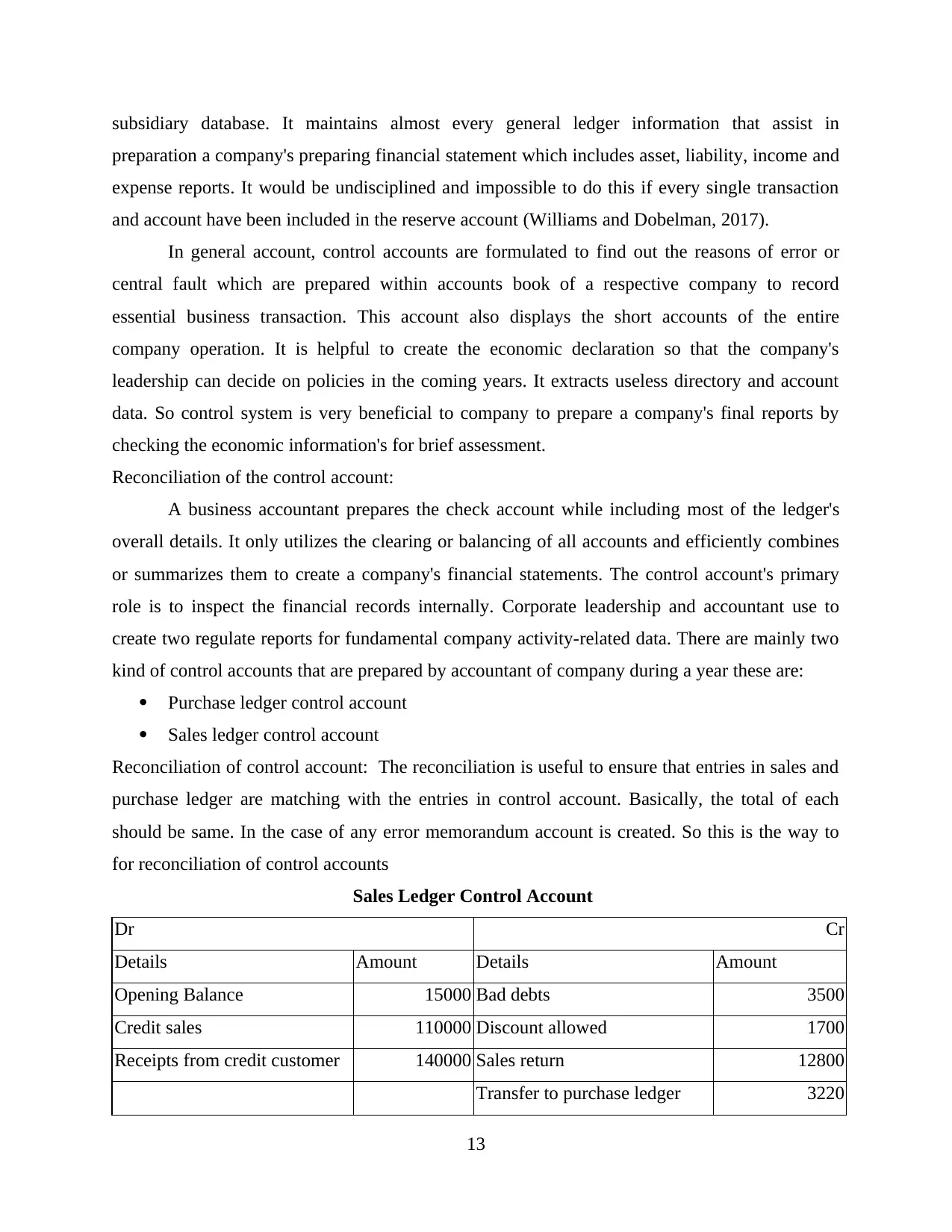
subsidiary database. It maintains almost every general ledger information that assist in
preparation a company's preparing financial statement which includes asset, liability, income and
expense reports. It would be undisciplined and impossible to do this if every single transaction
and account have been included in the reserve account (Williams and Dobelman, 2017).
In general account, control accounts are formulated to find out the reasons of error or
central fault which are prepared within accounts book of a respective company to record
essential business transaction. This account also displays the short accounts of the entire
company operation. It is helpful to create the economic declaration so that the company's
leadership can decide on policies in the coming years. It extracts useless directory and account
data. So control system is very beneficial to company to prepare a company's final reports by
checking the economic information's for brief assessment.
Reconciliation of the control account:
A business accountant prepares the check account while including most of the ledger's
overall details. It only utilizes the clearing or balancing of all accounts and efficiently combines
or summarizes them to create a company's financial statements. The control account's primary
role is to inspect the financial records internally. Corporate leadership and accountant use to
create two regulate reports for fundamental company activity-related data. There are mainly two
kind of control accounts that are prepared by accountant of company during a year these are:
Purchase ledger control account
Sales ledger control account
Reconciliation of control account: The reconciliation is useful to ensure that entries in sales and
purchase ledger are matching with the entries in control account. Basically, the total of each
should be same. In the case of any error memorandum account is created. So this is the way to
for reconciliation of control accounts
Sales Ledger Control Account
Dr Cr
Details Amount Details Amount
Opening Balance 15000 Bad debts 3500
Credit sales 110000 Discount allowed 1700
Receipts from credit customer 140000 Sales return 12800
Transfer to purchase ledger 3220
13
preparation a company's preparing financial statement which includes asset, liability, income and
expense reports. It would be undisciplined and impossible to do this if every single transaction
and account have been included in the reserve account (Williams and Dobelman, 2017).
In general account, control accounts are formulated to find out the reasons of error or
central fault which are prepared within accounts book of a respective company to record
essential business transaction. This account also displays the short accounts of the entire
company operation. It is helpful to create the economic declaration so that the company's
leadership can decide on policies in the coming years. It extracts useless directory and account
data. So control system is very beneficial to company to prepare a company's final reports by
checking the economic information's for brief assessment.
Reconciliation of the control account:
A business accountant prepares the check account while including most of the ledger's
overall details. It only utilizes the clearing or balancing of all accounts and efficiently combines
or summarizes them to create a company's financial statements. The control account's primary
role is to inspect the financial records internally. Corporate leadership and accountant use to
create two regulate reports for fundamental company activity-related data. There are mainly two
kind of control accounts that are prepared by accountant of company during a year these are:
Purchase ledger control account
Sales ledger control account
Reconciliation of control account: The reconciliation is useful to ensure that entries in sales and
purchase ledger are matching with the entries in control account. Basically, the total of each
should be same. In the case of any error memorandum account is created. So this is the way to
for reconciliation of control accounts
Sales Ledger Control Account
Dr Cr
Details Amount Details Amount
Opening Balance 15000 Bad debts 3500
Credit sales 110000 Discount allowed 1700
Receipts from credit customer 140000 Sales return 12800
Transfer to purchase ledger 3220
13
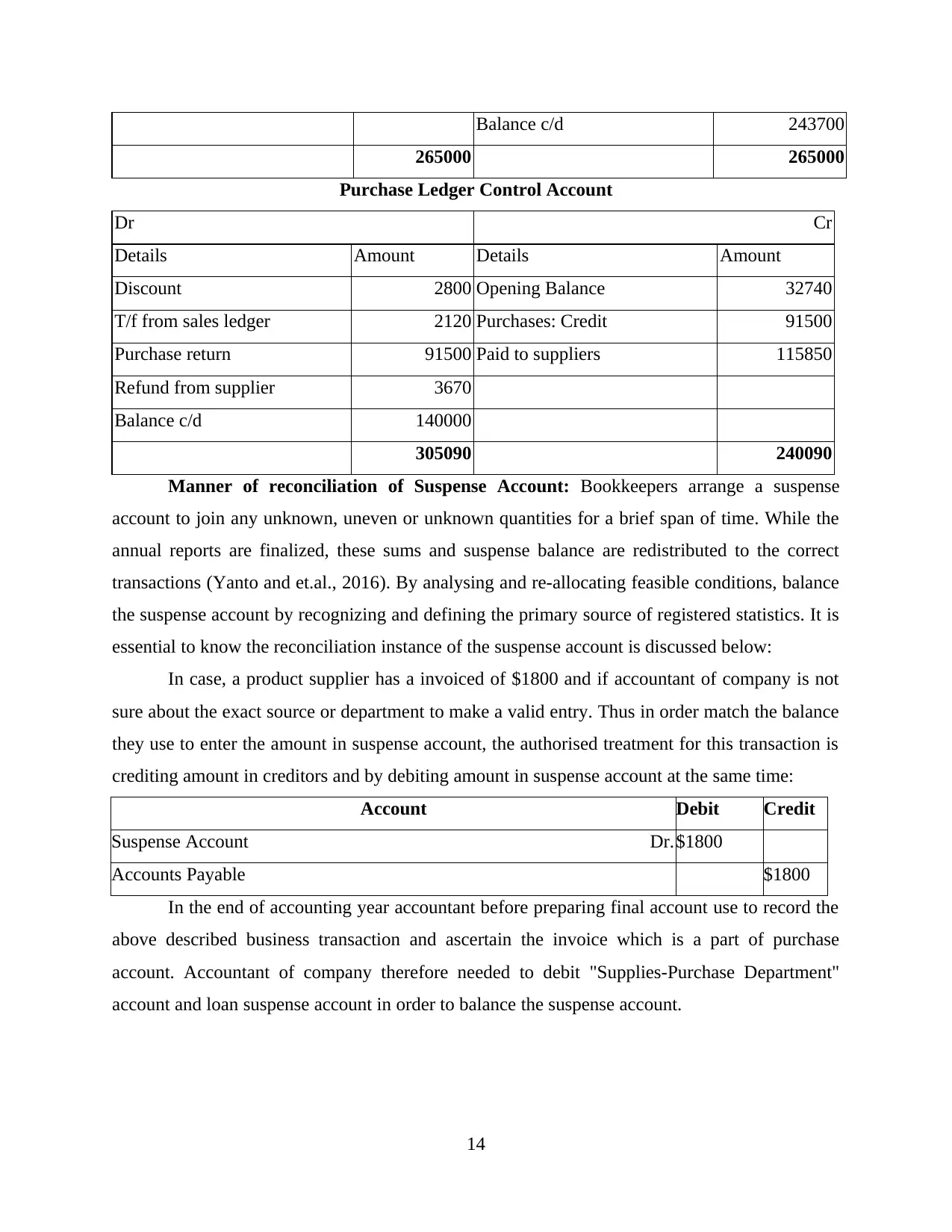
Balance c/d 243700
265000 265000
Purchase Ledger Control Account
Dr Cr
Details Amount Details Amount
Discount 2800 Opening Balance 32740
T/f from sales ledger 2120 Purchases: Credit 91500
Purchase return 91500 Paid to suppliers 115850
Refund from supplier 3670
Balance c/d 140000
305090 240090
Manner of reconciliation of Suspense Account: Bookkeepers arrange a suspense
account to join any unknown, uneven or unknown quantities for a brief span of time. While the
annual reports are finalized, these sums and suspense balance are redistributed to the correct
transactions (Yanto and et.al., 2016). By analysing and re-allocating feasible conditions, balance
the suspense account by recognizing and defining the primary source of registered statistics. It is
essential to know the reconciliation instance of the suspense account is discussed below:
In case, a product supplier has a invoiced of $1800 and if accountant of company is not
sure about the exact source or department to make a valid entry. Thus in order match the balance
they use to enter the amount in suspense account, the authorised treatment for this transaction is
crediting amount in creditors and by debiting amount in suspense account at the same time:
Account Debit Credit
Suspense Account Dr.$1800
Accounts Payable $1800
In the end of accounting year accountant before preparing final account use to record the
above described business transaction and ascertain the invoice which is a part of purchase
account. Accountant of company therefore needed to debit "Supplies-Purchase Department"
account and loan suspense account in order to balance the suspense account.
14
265000 265000
Purchase Ledger Control Account
Dr Cr
Details Amount Details Amount
Discount 2800 Opening Balance 32740
T/f from sales ledger 2120 Purchases: Credit 91500
Purchase return 91500 Paid to suppliers 115850
Refund from supplier 3670
Balance c/d 140000
305090 240090
Manner of reconciliation of Suspense Account: Bookkeepers arrange a suspense
account to join any unknown, uneven or unknown quantities for a brief span of time. While the
annual reports are finalized, these sums and suspense balance are redistributed to the correct
transactions (Yanto and et.al., 2016). By analysing and re-allocating feasible conditions, balance
the suspense account by recognizing and defining the primary source of registered statistics. It is
essential to know the reconciliation instance of the suspense account is discussed below:
In case, a product supplier has a invoiced of $1800 and if accountant of company is not
sure about the exact source or department to make a valid entry. Thus in order match the balance
they use to enter the amount in suspense account, the authorised treatment for this transaction is
crediting amount in creditors and by debiting amount in suspense account at the same time:
Account Debit Credit
Suspense Account Dr.$1800
Accounts Payable $1800
In the end of accounting year accountant before preparing final account use to record the
above described business transaction and ascertain the invoice which is a part of purchase
account. Accountant of company therefore needed to debit "Supplies-Purchase Department"
account and loan suspense account in order to balance the suspense account.
14
1 out of 16
Related Documents
Your All-in-One AI-Powered Toolkit for Academic Success.
+13062052269
info@desklib.com
Available 24*7 on WhatsApp / Email
![[object Object]](/_next/static/media/star-bottom.7253800d.svg)
Unlock your academic potential
© 2024 | Zucol Services PVT LTD | All rights reserved.





